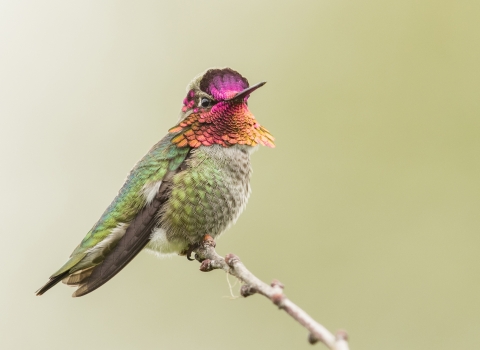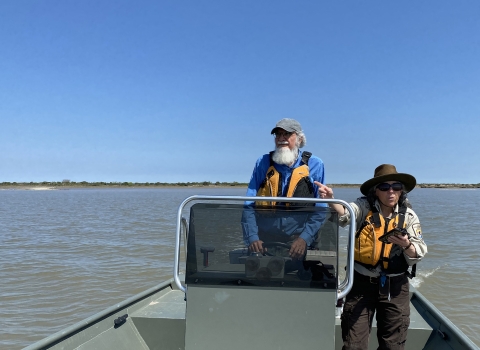The residents of Midway Atoll National Wildlife Refuge are always happy to have newcomers to their island, but now they have some very special guests. Twenty endangered Laysan ducks will now be calling Midway their home. Biologists from the U.S. Fish and Wildlife Service and the U.S. Geological Survey, Pacific Island Ecosystem Research Center brought the young ducks from the Hawaiian Islands National Wildlife Refuge to Midway on the evening of October 3.
"We are pleased with how well the ducks have traveled and adapted to their new home," said USGS's Dr. Michelle Reynolds, project leader for the Laysan Duck Translocation. "If survival is high and breeding successful, the Midway birds will be a crucial insurance population for the species.?
The endangered Laysan duck (Anas laysanesis) had the smallest geographical range of any duck species in the world and until now consisted of a single population of approximately 500 birds. Previously found only on the remote of Laysan in the Northwestern Hawaiian Islands, this species is one of only two endemic ? ?found nowhere else? ? ducks still found in Hawaii, the other being the Hawaiian duck or koloa (Anas wyvilliana). The Laysan duck was believed to be endemic to Laysan (it was found historically on neighboring Lisianski Island, but was extirpated in the early 20th century), but in 1995 evidence from bones revealed that the duck once inhabited the islands of Hawaii, Molokai, Maui, Oahu, and Kauai.
The first humans known to live on Laysan came in the 1890s to mine guano. They killed approximately 300,000 seabirds in six months. Humans also introduced rabbits that devastated the vegetation, turning the into a desert-like terrain and leading to the extinction of three endemic landbirds (Laysan Rail, Laysan Honeycreeper, and the Laysan Millerbird). The Laysan duck was also hunted for sport and for food, but it was the devegetation caused by the rabbits that drove the duck close to extinction. Its total population was recorded at 11 birds in 1911.
The duck was listed as endangered in 1966 because of its small population, limited distribution, and dependence upon a fragile ecosystem. The species faces high risk of extinction due to severe weather, disease, accidental introductions of nonnative plants and animals, and habitat degradation. The Fish and Wildlife Service developed a draft revised recovery plan for the species in 2004 (which is awaiting publication) with a long term goal of establishing four or more populations in order to downlist the species from endangered to threatened. This landmark event, translocating birds to Midway, seeks to create a second wild population of Laysan ducks and is a high priority for the recovery of the species.
The duck's risk of extinction is very high as long as it is limited to a single population. The species? disappearance from the main Hawaiian Islands was most likely due to the introduction of rats. Mammalian predators, such as mongooses, cats, and rats may be the most important limiting factor in the reintroduction of the duck to other sites. Rats were accidentally introduced to Midway during World War II, but were eliminated from the in 1997 after the atoll became a National Wildlife Refuge.
Midway Atoll NWR is located about 1,250 miles west-northwest of Honolulu. The five-mile diameter atoll was chosen as a reintroduction site because it lies within the presumed prehistoric range of the species, is free of rats and other predators, and provides the logistical feasibility for post-release monitoring of translocated ducks and for habitat restoration.
A team of project scientists and managers captured 27 birds on Laysan, and selected 20 of these birds to make the 2-day long boat ride to Midway. All personnel on the worked through the night to capture the birds. The candidate ducks were selected after six months of monitoring. Those that made the trip were chosen based on weight, sex (relatively even male-female ratio), health, age, and family history (a single duckling from each brood). Removal of the 20 birds from Laysan was not deemed a threat to the health of that population.
The birds were then transported on the "American Islander," a vessel contracted by the FWS for transport of the ducks and to change out field crews on Laysan. Each bird had its own transport cage, and the ducks had their own private cabin aboard the vessel. During this critical step of the translocation phase, the birds were fed, watered, and treated by USGS veterinarian Dr. Thierry Work, who was encouraged by the birds? body weights and condition during transport.
The young ducks have adapted well to their new home on Midway increasing their body weights 10-20% since their capture on Laysan. The ducks are being released with their aviary mates in groups of two, and are monitored closely for 48 hours before the next group is released. The released birds have already taken short flights, and have begun feeding on local foods such as emerald beetle grub and button sedge seeds.
FWS staff and volunteers at Midway Atoll NWR spent 18 months preparing the site for the arrival of the ducks. The first step in site preparation was the removal of nonnative ironwood trees and verbesina plants followed by the excavation of nine shallow freshwater seeps. In addition, 1,400 native bunch grass plants that are used by the ducks for nesting were planted at the site. Two separate aviaries were constructed using shade cloth and steel pipes. The aviaries have compartments measuring 100 square feet each. Two ducks occupy each compartment.
Radio transmitters have been attached to each bird so that they can be easily tracked after release from the aviary. The birds will be closely monitored with spotting scopes and radio telemetry to prevent disturbance. An additional translocation of 20-30 young ducks is planned for 2005.
"This is an exciting conservation project for Midway made possible thanks to the invaluable collaboration with USGS, our Midway contractor Chugach McKinley, FWS staff, and many volunteers," said John Klavitter, wildlife biologist for Midway Atoll NWR.
Laysan ducks are teal sized, between 15 and 17 inches in length, are brown with a bright green-blue to purple speculum (the distinctive feathers on the secondary wing feathers), and have a white area eye ring. Males have a blue-green bill with black spots along the upper mandible (bill). The female usually has more white around the head and neck, and has a dull brownish yellow bill. Both sexes have orange legs and feet. The ducks are primarily insect feeders, but may also feed on leaves and seeds.
The U.S. Fish and Wildlife Service is the principal Federal agency responsible for conserving, protecting, and enhancing fish, wildlife and plants and their habitats for the continuing benefit of the American people. The Service manages the 95-million-acre National Wildlife Refuge System, which encompasses 544 national wildlife refuges, thousands of small wetlands and other special management areas. It also operates 69 national fish hatcheries, 63 Fish and Wildlife Management offices and 81 ecological services field stations. The agency enforces federal wildlife laws, administers the Endangered Species Act, manages migratory bird populations, restores nationally significant fisheries, conserves and restores wildlife habitat such as wetlands, and helps foreign governments with their conservation efforts. It also oversees the Federal Assistance program, which distributes hundreds of millions of dollars in excise taxes on fishing and hunting equipment to state fish and wildlife agencies.


